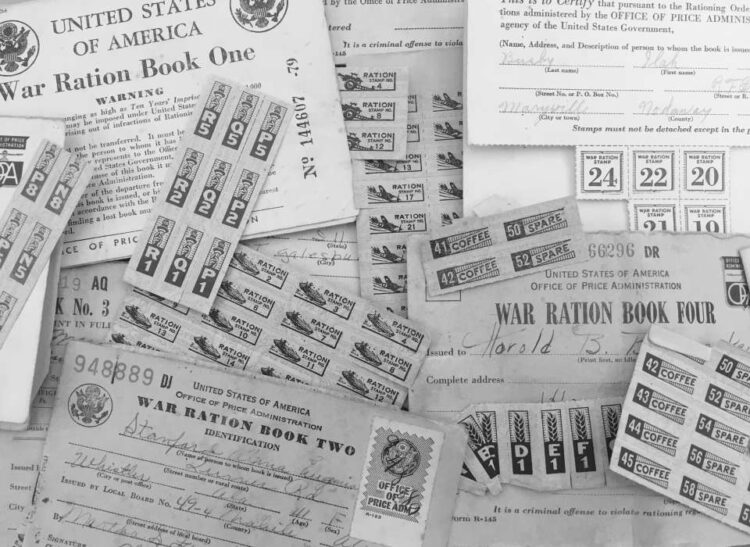U.S. Coffee Rationing in World War II
During World War II, the United States implemented coffee rationing as part of the broader war effort and conservation measures. The rationing of various goods, including coffee, was necessary to ensure that essential supplies were available for the military and to support the war economy.
Coffee had become an integral part of American culture and daily life, with many people relying on their daily cup to start the morning. However, during the war, transporting coffee beans from coffee-producing countries became difficult due to shipping disruptions caused by enemy action. Additionally, other priorities in wartime industries limited the availability of resources needed for coffee production and distribution.
In 1942, the U.S. government established the Office of Price Administration (OPA) to control inflation and regulate the prices of various goods. Coffee was one of the commodities that fell under OPA’s purview. On November 28, 1942, the U.S. government officially introduced coffee rationing. Each person over the age of 15 years was issued coffee ration cards that allowed them to purchase a limited amount of coffee per week. The initial ration was about one pound of coffee every five weeks, which meant that individuals had to make their coffee supplies last.

During World War II, black-marketing, also known as black market activities, was a significant issue in the United States, as it was in many other countries involved in the war. Black-market activities involved the illegal buying, selling, and trading of goods and commodities that were in short supply or subject to rationing due to the war effort. These illicit transactions took place outside of official channels and often involved price gouging and profiteering. Black-market operators saw an opportunity to profit by exploiting the shortages and rationing restrictions. They obtained goods through illegal means, such as hoarding, smuggling, or stealing, and then sold them at inflated prices to consumers who were willing to pay a premium to get scarce items. Food items like meat, sugar, coffee, and butter, as well as fuel such as gasoline and heating oil, were some of the most commonly rationed commodities. Black-market activities involving these goods were prevalent, with individuals and organized networks engaging in illegal trade.
Popular brands during WW2
Maxwell House is one of the oldest and most renowned coffee brands in the United States. Its coffee gained popularity in the early 20th century and continued to be a household name during WW2. Maxwell House was known for its slogan “Good to the last drop.”
Folgers is another iconic coffee brand that gained popularity in the United States. Its catchy jingle “The best part of waking up is Folgers in your cup” became ingrained in American culture.
Nescafé, produced by Nestlé, was one of the pioneers of instant coffee. Its convenience and easy preparation made it popular during the war years when resources were limited.
Chase & Sanborn was a prominent coffee brand during WW2. It gained popularity for its quality coffee blends.
MJB Coffee was another well-known coffee brand during the war era. It offered various coffee blends to suit different tastes.
Community Coffee, based in Louisiana, was popular in the Southern United States. It became a favorite in many households during WW2.
Luzianne Coffee, known for its coffee blends and teas, was popular in the Southern United States during WW2.
Ration Books
The “C” Stamp: To enforce rationing, coffee packages were marked with a “C” stamp, indicating that the contents were subject to rationing restrictions. Retailers were required to keep records of coffee sales and ensure that customers did not exceed their allotted ration. With coffee becoming scarce and rationed, people sought alternatives to fulfill their caffeine cravings. Some turned to chicory, a plant root often roasted and used as a coffee substitute. Other caffeine-containing beverages, such as tea, also gained popularity during this time.
Coffee rationing was not without its challenges. While most Americans understood the necessity of rationing during wartime, there were some complaints and adjustments to be made in daily habits. Rationing became a symbol of the war’s impact on civilian life and daily routines. Coffee rationing continued throughout the war years but came to an end in July 1943. After the war, coffee supplies returned to normal, and the rationing restrictions were lifted. Americans once again enjoyed the freedom to consume coffee without the limitations imposed by ration cards.
Source
https://www.history.com/news/food-rationing-in-wartime-america
https://collections.nlm.nih.gov/catalog/nlm:nlmuid-14110590R-bk
chrome-extension://efaidnbmnnnibpcajpcglclefindmkaj/https://princetonhistory.org/wp-content/uploads/2020/04/HSP_WWIIRationing_RemoteLearningActivity_2.pdf
